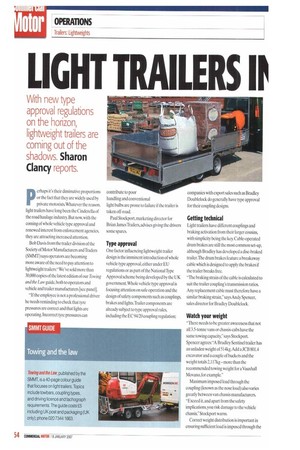LIGHT TRA LERS IP
Page 54

If you've noticed an error in this article please click here to report it so we can fix it.
With new type approval regulations on the horizon, lightweight trailers are coming out of the
shadows. Sharon Clancy reports.
perhaps it's their diminutive proportions or the fact that they are widely used by private motorists Whatever the reason, light trailers have long been the Cinderella of the road haulage industry. But now, with the coming of whole vehicle type approval and renewed interest from enforcement agencies, they are attracting increased attention.
Bob Davis from the trailer division of the Society of Motor Manufacturers and Traders (SMMT) says operators are becoming more aware of the need to pay attention to lightweight trailers:"We've sold more than 30,000 copies of the latest edition of our Towing and the Law guide, both to operators and vehicle and trailer manufacturers [see panel].
"If the employee is not a professional driver he needs reminding to check that tyre pressures are correct and that lights are operating. Incorrect tyre pressures can contribute to poor handling and conventional light bulbs are prone to failure if the trailer is taken off-road.
Paul Stockport, marketing director for Brian James Trailers, advises giving the drivers some spares.
Type approval
One factor influencing lightweight trailer design is the imminent introduction of whole vehicle type approval, either under EU regulations or as part of the National Type Approval scheme being developed by the UK government.Whole vehicle type approval is focusing attention on safe operation and the design of safety components such as couplings, brakes and lights.Trailer components are already subject to type approval rules, including the EC 94/20 coupling regulation; companies with export sales such as Bradley Doublelock do generally have type approval for their coupling designs.
Getting technical
Light trailers have different couplings and braking activation from their larger cousins, with simplicity being the key. Cable-operated drum brakes are still the most common set-up, although Bradley has developed a disc-braked trailer.The drum brakes feature a breakaway cable which is designed to apply the brakes if the trailer breaks free.
-The braking strain of the cable is calculated to suit the trailer coupling's transmission ratios. Any replacement cable must therefore have a similar braking strain," says Andy Spencer, sales director for Bradley Doublelock.
Watch your weight
-There needs to be greater awareness that not all 3.5-tonne vans or chassis-cabs have the same towing capacity," says Stockport. Spencer agrees: "A Bradley Sentinel trailer has an unladen weight of 514kg. Add a JCB 801.4 excavator and a couple of buckets and the weight totals 2,117kg —more than the recommended towing weight for a Vauxhall Movano, for example."
Maximum imposed load through the coupling (known as the nose load) also varies greatly between van chassis manufacturers. "Exceed it, and apart from the safety implications, you risk damage to the vehicle chassis," Stockport warns.
Correct weight distribution is important in ensuring sufficient load is imposed through the






















































































































































































